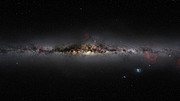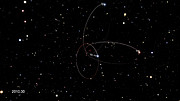Artist's impression of the orbits of stars close to the Galactic Centre
Artist's impression of the effect of general relativity on the orbit of the S2 star at the Galactic Centre
Image of the Galactic Centre
Videos

ESOcast 121 Light: Star orbiting supermassive black hole suggests Einstein is right (4K UHD)
Orbits of three stars very close to the centre of the Milky Way
[2] S2 is a 15-solar-mass star on an elliptical orbit around the supermassive black hole. It has a period of about 15.6 years and gets as close as 17 light-hours to the black hole — or just 120 times the distance between the Sun and the Earth.
A new analysis of data from ESO’s Very Large Telescope and
other telescopes suggests that the orbits of stars around the
supermassive black hole at the centre of the Milky Way may show the
subtle effects predicted by Einstein’s general theory of relativity.
There are hints that the orbit of the star S2 is deviating slightly from
the path calculated using classical physics. This tantalising result is
a prelude to much more precise measurements and tests of relativity
that will be made using the GRAVITY instrument as star S2 passes very
close to the black hole in 2018.
At the centre of the Milky Way, 26 000 light-years from Earth, lies the closest supermassive black hole,
which has a mass four million times that of the Sun. This monster is
surrounded by a small group of stars orbiting at high speed in the black
hole’s very strong gravitational field. It is a perfect environment in
which to test gravitational physics, and particularly Einstein’s
general theory of relativity.
A team of German and Czech astronomers have now applied new analysis
techniques to existing observations of the stars orbiting the black
hole, accumulated using ESO’s Very Large Telescope (VLT) in Chile and others over the last twenty years [1]. They compare the measured star orbits to predictions made using classical Newtonian gravity as well as predictions from general relativity.
The team found suggestions of a small change in the motion of one of
the stars, known as S2, that is consistent with the predictions of
general relativity [2].
The change due to relativistic effects amounts to only a few percent in
the shape of the orbit, as well as only about one sixth of a degree in
the orientation of the orbit [3].
If confirmed, this would be the first time that a measurement of the
strength of the general relativistic effects has been achieved for stars
orbiting a supermassive black hole.
Marzieh Parsa, PhD student at the University of Cologne, Germany and lead author of the paper, is delighted: "The
Galactic Centre really is the best laboratory to study the motion of
stars in a relativistic environment. I was amazed how well we could
apply the methods we developed with simulated stars to the
high-precision data for the innermost high-velocity stars close to the
supermassive black hole."
The high accuracy of the positional measurements, made possible by
the VLT’s near-infrared adaptive optics instruments, was essential for
the study [4].
These were vital not only during the star’s close approach to the black
hole, but particularly during the time when S2 was further away from
the black hole. The latter data allowed an accurate determination of the
shape of the orbit.
"During the course of our analysis we realised that to determine
relativistic effects for S2 one definitely needs to know the full orbit
to very high precision," comments Andreas Eckart, team leader at the University of Cologne.
As well as more precise information about the orbit of the
star S2, the new analysis also gives the mass of the black hole and its
distance from Earth to a higher degree of accuracy [5].
Co-author Vladimir Karas from the Academy of Sciences in Prague, the Czech Republic, is excited about the future: "This opens up an avenue for more theory and experiments in this sector of science."
This analysis is a prelude to an exciting period for observations of
the Galactic Centre by astronomers around the world. During 2018 the
star S2 will make a very close approach to the supermassive black hole.
This time the GRAVITY instrument,
developed by a large international consortium led by the
Max-Planck-Institut für extraterrestrische Physik in Garching, Germany [6], and installed on the VLT Interferometer [7],
will be available to help measure the orbit much more precisely than is
currently possible. Not only is GRAVITY, which is already making
high-precision measurements of the Galactic Centre, expected to reveal
the general relativistic effects very clearly, but also it will allow
astronomers to look for deviations from general relativity that might
reveal new physics.
Notes
[1] Data from the near-infrared NACO camera now at VLT Unit Telescope 1 (Antu) and the near-infrared imaging spectrometer SINFONI at the Unit Telescope 4 (Yepun) were used for this study. Some additional published data obtained at the Keck Observatory were also used.
[2] S2 is a 15-solar-mass star on an elliptical orbit around the supermassive black hole. It has a period of about 15.6 years and gets as close as 17 light-hours to the black hole — or just 120 times the distance between the Sun and the Earth.
[3] A similar, but much
smaller, effect is seen in the changing orbit of the planet Mercury in
the Solar System. That measurement was one of the best early pieces of
evidence in the late nineteenth century suggesting that Newton’s view of
gravity was not the whole story and that a new approach and new
insights were needed to understand gravity in the strong-field case.
This ultimately led to Einstein publishing his general theory of
relativity, based on curved spacetime, in 1915.
When the orbits of stars or planets are calculated using
general relativity, rather than Newtonian gravity, they evolve
differently. Predictions of the small changes to the shape and
orientation of orbits with time are different in the two theories and
can be compared to measurements to test the validity of general
relativity.
[4] An adaptive optics
system compensates for the image distortions produced by the turbulent
atmosphere in real time and allows the telescope to be used at much
angular resolution (image sharpness), in principle limited only by the
mirror diameter and the wavelength of light used for the observations.
[5] The team finds a black hole mass of 4.2 × 106 times the mass of the Sun, and a distance from us of 8.2 kiloparsecs, corresponding to almost 27 000 light-years.
[6] The University of Cologne is part of the GRAVITY team (http://www.mpe.mpg.de/ir/gravity) and contributed the beam combiner spectrometers to the system.
More Information
This
research was presented in a paper entitled “Investigating the
Relativistic Motion of the Stars Near the Black Hole in the Galactic
Center”, by M. Parsa et al., to be published in the Astrophysical Journal.
The team is composed of Marzieh Parsa, Andreas Eckart
(I.Physikalisches Institut of the University of Cologne, Germany; Max
Planck Institute for Radio Astronomy, Bonn, Germany), Banafsheh
Shahzamanian (I.Physikalisches Institut of the University of Cologne,
Germany), Christian Straubmeier (I.Physikalisches Institut of the
University of Cologne, Germany), Vladimir Karas (Astronomical Institute,
Academy of Science, Prague, Czech Republic), Michal Zajacek (Max Planck
Institute for Radio Astronomy, Bonn, Germany; I.Physikalisches Institut
of the University of Cologne, Germany) and J. Anton Zensus (Max Planck
Institute for Radio Astronomy, Bonn, Germany).
ESO is the foremost intergovernmental astronomy
organisation in Europe and the world’s most productive ground-based
astronomical observatory by far. It is supported by 16 countries:
Austria, Belgium, Brazil, the Czech Republic, Denmark, France, Finland,
Germany, Italy, the Netherlands, Poland, Portugal, Spain, Sweden,
Switzerland and the United Kingdom, along with the host state of Chile.
ESO carries out an ambitious programme focused on the design,
construction and operation of powerful ground-based observing facilities
enabling astronomers to make important scientific discoveries. ESO also
plays a leading role in promoting and organising cooperation in
astronomical research. ESO operates three unique world-class observing
sites in Chile: La Silla, Paranal and Chajnantor. At Paranal, ESO
operates the Very Large Telescope and its world-leading Very Large
Telescope Interferometer as well as two survey telescopes, VISTA working
in the infrared and the visible-light VLT Survey Telescope. ESO is also
a major partner in two facilities on Chajnantor, APEX and ALMA, the
largest astronomical project in existence. And on Cerro Armazones, close
to Paranal, ESO is building the 39-metre Extremely Large Telescope, the
ELT, which will become “the world’s biggest eye on the sky”.
Links
Links
- Research paper in the Astrophysical Journal
- Final online version of paper
- Earlier VLT observations of the Galactic Centre (eso0846, eso1151, eso1332 and eso1512)
- MPE web page on the Galactic Centre
- Photos of the VLT
Contacts
Marzieh Parsa
I. Physikalisches Institut, Universität zu Köln
Köln, Germany
Tel: +49(0)221/470-3495
Email: parsa@ph1.uni-koeln.de
Andreas Eckart
I. Physikalisches Institut, Universität zu Köln
Köln, Germany
Tel: +49(0)221/470-3546
Email: eckart@ph1.uni-koeln.de
Vladimir Karas
Astronomical Institute, Academy of Science
Prague, Czech Republic
Tel: +420-226 258 420
Email: vladimir.karas@cuni.cz
Richard Hook
ESO Public Information Officer
Garching bei München, Germany
Tel: +49 89 3200 6655
Cell: +49 151 1537 3591
Email: rhook@eso.org
Source: ESO/News



